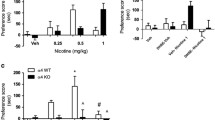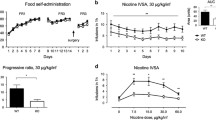Abstract
Rationale
The mesolimbic dopamine (DA) system is considered a principal site for nicotine–cocaine interactions.
Objectives and methods
The aim of this paper is to study the effects of local perfusions (through the microdialysis cannula) of nicotinic acetylcholine receptor (nAChR) antagonists in the ventral tegmental area (VTA, where mesolimbic DA cell bodies are located) or nucleus accumbens (nAc, where mesolimbic DA nerve terminals project) on cocaine-elicited increase in DA levels in the nAc of mice using intracerebral microdialysis.
Results
Intra-nAc perfusion of mecamylamine (a nonselective central nicotinic antagonist) or coperfusion of methyllycaconitine (MLA, 10 nM) and dihydro-β-erythroidine (DHβE, 10–100 μM) decreased cocaine-elicited increase in DA perfusate levels. In contrast, intra-nAc perfusion of MLA alone (a relatively selective antagonist of α7 subunit-containing nAChRs) increased, while DHβE (a relatively selective antagonist of heteromeric nAChR subtypes) did not alter, cocaine-elicited increase in DA perfusate levels. Intra-VTA perfusion of MLA (100 nM) or DHβE (100 μM) significantly increased the cocaine-elicited increase of DA levels in the nAc or VTA, whereas DHβE and MLA coperfusion or mecamylamine perfusion had no significant effect.
Conclusions
These results show that intra-nAc and intra-VTA perfusion of nAChR antagonists differentially affect cocaine-elicited increase in DA levels in a region and subtype-specific manner. This suggests that multiple cholinergic/nicotinic pathways influence the effects of cocaine on mesolimbic DA neurons in complex, and sometimes opposing, patterns.










Similar content being viewed by others
References
Adell A, Artigas F (2004) The somatodendritic release of dopamine in the ventral tegmental area and its regulation by afferent transmitter systems. Neurosci Biobehav Rev 28:415–431
Balfour DJ (2002) Neuroplasticity within the mesoaccumbens dopamine system and its role in tobacco dependence. Curr Drug Target CNS Neurol Disord 1:413–421
Bechtholt AJ, Mark GP (2002) Enhancement of cocaine-seeking behavior by repeated nicotine exposure in rats. Psychopharmacology (Berl) 162:178–185
Blokhina EA, Kashkin VA, Zvartau EE, Danysz W, Bespalov AY (2005) Effects of nicotinic and NMDA receptor channel blockers on intravenous cocaine and nicotine self-administration in mice. Eur Neuropsychopharmacol 15:219–225
Budney AJ, Higgins ST, Hughes JR, Bickel WK (1993) Nicotine and caffeine use in cocaine-dependent individuals. J Subst Abuse 5:117–130
Champtiaux N, Kalivas PW, Bardo MT (2006) Contribution of dihydro-beta-erythroidine sensitive nicotinic acetylcholine receptors in the ventral tegmental area to cocaine-induced behavioral sensitization in rats. Behav Brain Res 168:120–126
Chaurasia CS (1999) In vivo microdialysis sampling: theory and applications. Biomed Chromatogr 13:317–332
Chavez-Noriega LE, Crona JH, Washburn MS, Urrutia A, Elliott KJ, Johnson EC (1997) Pharmacological characterization of recombinant human neuronal nicotinic acetylcholine receptors h alpha 2 beta 2, h alpha 2 beta 4, h alpha 3 beta 2, h alpha 3 beta 4, h alpha 4 beta 2, h alpha 4 beta 4 and h alpha 7 expressed in Xenopus oocytes. J Pharmacol Exp Ther 280:346–356
Chen SY, Burger RL, Reith MEA (1996) Extracellular dopamine in the rat ventral tegmental area and nucleus accumbens following ventral tegmental infusion of cocaine. Brain Res 729:294–296
Consolo S, Caltavuturo C, Colli E, Recchia M, Di Chiara G (1999) Different sensitivity of in vivo acetylcholine transmission to D1 receptor stimulation in shell and core of nucleus accumbens. Neuroscience 89:1209–1217
Dani JA, Heinemann S (1996) Molecular and cellular aspects of nicotine abuse. Neuron 16:905–908
Day JC, Piazza PV, Le-Moal M, Maccari S (1997) Cocaine-induced increase in cortical acetylcholine release: interaction with the hypothalamo–pituitary–adrenal axis. Eur J Neurosci 9:1130–1136
Di Chiara G, Bassareo V, Fenu S, De Luca MA, Spina L, Cadoni C, Acquas E, Carboni E, Valentini V, Lecca D (2004) Dopamine and drug addiction: the nucleus accumbens shell connection. Neuropharmacology 47(Suppl 1):227–241
Ferrari R, Le Novère N, Picciotto MR, Changeux JP, Zoli M (2002) Acute and long-term changes in mesolimbic dopamine pathway after systemic or local single nicotine injections. Eur J Neurosci 15:1810–1818
Franklin KBJ, Paxinos G (1997) The mouse brain in stereotaxic coordinates. Academic, San Diego, USA
Harvey SC, Luetje CW (1996) Determinants of competitive antagonist sensitivity on neuronal nicotinic receptor beta subunits. J Neurosci 16:3798–3806
Horger BA, Giles MK, Schenk S (1992) Preexposure to amphetamine and nicotine predisposes rats to self-administer a low dose of cocaine. Psychopharmacology 107:271–276
Imperato A, Obinu MC, Gessa GL (1993) Effects of cocaine and amphetamine on acetylcholine release in the hippocampus and caudate nucleus. Eur J Pharmacol 238:377–381
Jaffe EH, Marty A, Schulte A, Chow RH (1998) Extrasynaptic vesicular transmitter release from the somata of substantia nigra neurons in rat midbrain slices. J Neurosci 18:3548–3553
Jones IW, Wonnacott S (2004) Precise localization of alpha7 nicotinic acetylcholine receptors on glutamatergic axon terminals in the rat ventral tegmental area. J Neurosci 24:11244–11252
Klink R, de Kerchove-d’Exaerde A, Zoli M, Changeux JP (2001) Molecular and physiological diversity of nicotinic acetylcholine receptors in the midbrain dopaminergic nuclei. J Neurosci 21:1452–1463
Koob GF, Nestler EJ (1997) The neurobiology of drug addiction. J Neuropsychiatry Clin Neurosci 9:482–497
Levin ED, Mead T, Rezvani AH, Rose JE, Gallivan C, Gross R (2000) The nicotinic antagonist mecamylamine preferentially inhibits cocaine vs. food self-administration in rats. Physiol Behav 71:565–570
Lindsay GB, Rainey J (1997) Psychosocial and pharmacologic explanations of nicotine’s “gateway drug” function. J Sch Health 67:123–126
Mameli-Engvall M, Evrard A, Pons S, Maskos U, Svensson TH, Changeux JP, Faure P (2006) Hierarchical control of dopamine neuron-firing patterns by nicotinic receptors. Neuron 50:911–921
Mansvelder HD, Keath R, McGehee DS (2002) Synaptic mechanisms underlie nicotine-induced excitability of brain reward areas. Neuron 33:905–919
Mateo Y, Lack CM, Morgan D, Roberts DC, Jones SR (2005) Reduced dopamine terminal function and insensitivity to cocaine following cocaine binge self-administration and deprivation. Neuropsychopharmacology 30:1455–1463
Picciotto MR, Zoli M, Rimondini R, Léna C, Marubio LM, Merlo Pich E, Fuxe K, Changeux JP (1998) Acetylcholine receptors containing the beta-2 subunit are involved in the reinforcing properties of nicotine. Nature 391:173–177
Rahman S, Zhang J, Corrigall WA (2004) Local perfusion of nicotine differentially modulates somatodendritic dopamine release in the rat ventral tegmental area after nicotine preexposure. Neurochem Res 29:1687–1693
Reid MS, Mickalian JD, Delucchi KL, Hall SM, Berger SP (1998) An acute dose of nicotine enhances cue-induced cocaine craving. Drug Alcohol Depend 49:95–104
Reid MS, Mickalian JD, Delucchi KL, Berger SP (1999) A nicotine antagonist, mecamylamine, reduces cue-induced cocaine craving in cocaine-dependent subjects. Neuropsychopharmacology 20:297–307
Schoffelmeer AN, De Vries TJ, Wardeh G, van de Ven HW, Vanderschuren LJ (2002) Psychostimulant-induced behavioral sensitization depends on nicotinic receptor activation. J Neurosci 22:3269–3276
Stauderman KA, Mahaffy LS, Akong M, Velicelebi G, Chavez-Noriega LE, Crona JH, Johnson EC, Elliott KJ, Gillespie A, Reid RT, Adams P, Harpold MM, Corey-Naeve J (1998) Characterization of human recombinant neuronal nicotinic acetylcholine receptor subunit combinations alpha2beta4, alpha3beta4 and alpha4beta4 stably expressed in HEK293 cells. J Pharmacol Exp Ther 284:777–789
Wooltorton JR, Pidoplichko VI, Broide RS, Dani JA (2003) Differential desensitization and distribution of nicotinic acetylcholine receptor subtypes in midbrain dopamine areas. J Neurosci 23:3176–3185
Wu J, George AA, Schroeder KM, Xu L, Marxer-Miller S, Lucero L, Lukas RJ (2004) Electrophysiological, pharmacological, and molecular evidence for alpha7-nicotinic acetylcholine receptors in rat midbrain dopamine neurons. J Pharmacol Exp Ther 311:80–91
Xiao Y, Meyer EL, Thompson JM, Surin A, Wroblewski J, Kellar KJ (1998) Rat alpha3/beta4 subtype of neuronal nicotinic acetylcholine receptor stably expressed in a transfected cell line: pharmacology of ligand binding and function. Mol Pharmacol 54:322–333
Zachariou V, Caldarone BJ, Weathers-Lowin A, George TP, Elsworth JD, Roth RH, Changeux J-P, Picciotto MR (2001) Nicotine receptor inactivation decreases sensitivity to cocaine. Neuropsychopharmacology 24:576–589
Zanetti L, De Kerchove D’Exaerde A, Zanardi A, Changeux JP, Picciotto MR, Zoli M (2006) Inhibition of both α7* and β2* nicotinic acetylcholine receptors is necessary to prevent development of sensitization to cocaine-elicited increases in extracellular dopamine levels in the ventral striatum. Psychopharmacology 187:181–188
Zoli M, Moretti M, Zanardi A, McIntosh JM, Clementi F, Gotti C (2002) Identification of the nicotinic receptor subtypes expressed on dopaminergic terminals in the rat striatum. J Neurosci 22:8785–8789
Acknowledgements
The work was supported by grants from the Italian MIUR (MM05152538) (M.Z.) and grants #DA00436, DA14241 and AA15632 from the National Institutes of Health (M.R.P.). The authors have no financial interest in or financial conflict with the subject matter or materials discussed in the manuscript.
Author information
Authors and Affiliations
Corresponding author
Rights and permissions
About this article
Cite this article
Zanetti, L., Picciotto, M.R. & Zoli, M. Differential effects of nicotinic antagonists perfused into the nucleus accumbens or the ventral tegmental area on cocaine-induced dopamine release in the nucleus accumbens of mice. Psychopharmacology 190, 189–199 (2007). https://doi.org/10.1007/s00213-006-0598-6
Received:
Accepted:
Published:
Issue Date:
DOI: https://doi.org/10.1007/s00213-006-0598-6




